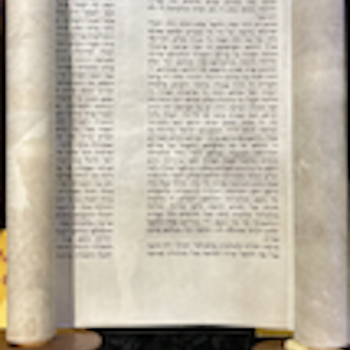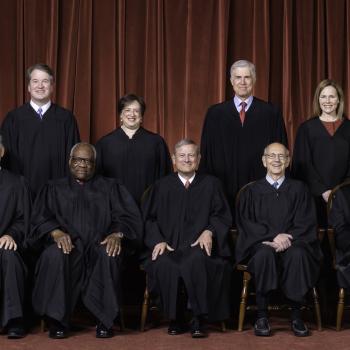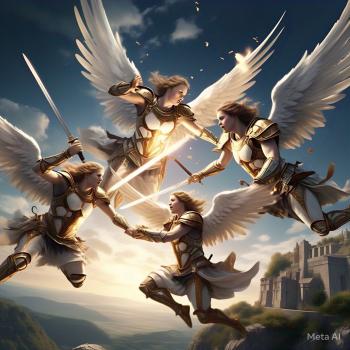Hal Lindsey
Hal Lindsey and I come from the same church in Houston, Texas. It is an independent Bible church called Berachah Church. (Berachah is the Hebrew word for “blessing.”) In my first year in college, at eighteen years of age, I attended a Campus Crusade for Christ (CCC) retreat for college students. The pastor of my new church, Robert B. Thieme Jr., and Hal Lindsey were the two keynote speakers. (At that time, Lindsey was a traveling speaker for CCC.) When Lindsey spoke that first evening, it was the first time I had heard him, and he turned me on to Bible prophecy.
Lindsey had first been taught Dispensational eschatology by Thieme. Then Lindsey got further teaching on this when he attended Dallas Theological Seminary. So, I was taught Dispensationalist eschatology by Thieme for the next several years as well.
Ten years after I first heard Lindsey, the timing was right for the publication of his first book on Bible prophecy, entitled The Late Great Planet Earth (LGPE). Jews had lost their nation back in 135 CE. Then they were scattered throughout the world. There they remained for nearly 1,800 years. Moses had predicted in the Torah that this would happen (Lev 26.33; Deut 28.64; 30.1).
Russian pogroms in the 1880s caused some Russian Jews to migrate to their ancestral land–the Land of Israel. Over the next half century, some Jews from other parts of the world did likewise. Thus, in 1948, Israel became a nation again. And in 1967, Israel captured the Old City of Jerusalem in the Six Days War. Many Jews, and not a few western Christians, were euphoric about it. Jews regaining their nation in their ancestral land was a fulfillment of Bible prophecy, at least in Ezekiel 38.8.
Lindsey wrote all about this in his mega-selling, first book that eventually sold reportedly 35 million copies. Astonishingly, prior to that no book about Bible prophecy had ever even come close to selling a million copies. At the end of the 1970s, Time magazine declared it “the book of the decade.”
Nevertheless, Hal Lindsey made a serious blunder in LGPE regarding Jesus’ Olivet Discourse. Jesus had said concerning the endtimes, “From the fig tree learn its lesson: as soon as its branch becomes tender and puts forth its leaves, you know that summer is near. So also, when you see (all) these things [he had just predicted], you know that he is near [referring to himself as the Son of Man], at the very gates. Truly I tell you, this generation will not pass away until all these things have taken place” (Matt. 24.32-34; Mark 13.28-30 NRSV).
Lindsey interpreted “this generation” in Jesus’ parable of the fig tree to mean that it was symbolic of modern Israel because the Bible sometimes refers to the fig tree as a symbol of Israel. But Bible students should always be careful in studying the synoptic gospels in the New Testament by comparing them regarding Jesus’ sayings and acts. This is easily done with a “parallel-column harmony” of the the four gospels in the New Testament, or at least with the synoptics (first three gospels).
In this case, Luke says Jesus said, “Look at the fig tree and all the trees” (Luke 21.29). Matthew and Mark do not include “and all the the trees.” Obviously, if Luke’s addition about the other trees is correct, and we have no reason to believe that it isn’t correct, especially if you believe as I do in the divine inspiration of these gospels, Jesus could not have meant that he was in this case using the fig tree exclusively as a symbol of Israel. It’s just that the fig three has large leaves, and they are the first to bud forth in early spring.
Lindsey says in LGPE (p. 43) regarding Jesus’ use of the word generation, “What generation? Obviously, in context, the generation that would see the signs–chief among them the rebirth of Israel. A generation in the Bible is something like forty years. If this is a correct deduction, then within forty years or so of 1948, all these things could take place.” At least Lindsey hedged by inserting his qualifying word “could,” which is something he often does in LGPE. He was saying Jesus could return to establish his worldwide, glorious kingdom in 1988. That teaching seems to have been original with Lindsey; he definitely didn’t get it from Thieme at Berachah Church.
So, Hal Lindsey also believes in pretribulationism, meaning that Jesus will return only to the earth’s sky to “rapture” his church to heaven seven years before he will return to earth to establish his kingdom. Thus, Lindsey was saying in LGPE that the rapture could occur in 1981. When the year 1981 came, not a few American Evangelical Christians familiar with Lindsey’s book wondered if the rapture was going to happen then. Some were absolutely certain of it. One of them was Rainbow Man.
Rollen Stewart
Rollen Stewart (b. 1944) was known as Rock’n’ Rollen. He became a fixture in the American, televised, professional sports scene throughout the 1980s. He would attend televised, sporting events—especially PGA Tour golf tournaments and NFL Monday Night football games. And when he did, he would always wear a large, multi-colored, afro-style wig. That’s how he also got his nickname Rainbow Man. Then he would strategically position himself in the path of a television camera and hold up a sign with a Bible reference on it. The reference was usually “JOHN 3:16.” (That is my favorite verse in the Bible and the one I often wrote under my name when I signed autographs.) Nearly all U.S. sports fans during the 1980s knew about Rock’n Rollen and his antics of getting on television with his sign showing a short Bible verse or only its reference.
But before all of this happened, Rollen Stewart lived near my birthplace and boyhood hometown—Seattle, Washington. He owned a small ranch there with a house. Rollen professedly was a drug addict, hippie-type guy. He started attending parties and sporting events to get media attention by wearing only a loin cloth made of animal fur and a large, multi-colored wig. He says his purpose for doing this was mostly to get women interested in him and have sex with them.
But in 1980, Rollen Stewart had a dramatic change of life-style by becoming a professedly “born-again Christian.” It happened while he was watching television preacher Charles R. Taylor on his show, “Today in Bible Prophecy.” In a 1982 Golf Digest interview article, Rollen Stewart testified that at that moment he despaired of his shallow life filled with drugs and sex. He says he then “turned my life over to Jesus.”
Rollen Stewart then sold his property and spent that money on his activity of attending sporting events and trying to get on national television. But he was doing it for Jesus. And he was getting famous for it. He once appeared in an Anheuser-Busch television commercial. It showed him attending parties and sporting events, dancing, and whooping it up while wearing his rainbow wig. His novel character even got featured on Saturday Night Live, The Tonight Show, and in Charles Schultz’s Peanuts cartoon strip.
During the early years of Stewart’s prolonged television spectacle, he traveled the U.S. in his car and lived in it to save on expenses in order to attend sporting events. Later, his wife and other associates assisted him. He soon relied on donations. Some of the PGA Tour pros who regularly attended the weekly PGA Tour Bible Study group were friends with Rollen Stewart and donated financially to his cause.
Yes, I knew Rollen Stewart. I’ll tell one story about Rock’n Rollen and me. In 1982, I competed for the last time in the PGA Tour’s Kemper Open. It was then held at the Congressional Country Club in Washington, D.C. Rollen was there, wearing his colorful rainbow wig and passing out Christian tracts to the golf fans. Actually, Rollen had a lot more fans asking him for his autograph than I did. I was intermittently talking to him and reading the tract he had just given me which he had written. It was about the rapture of the church. In it, Rollen predicted that the rapture would occur in 1981, just as Hal Lindsey uniquely had led many American Evangelical Christians to believe.
I then said to Rollen, “Hey, dude, this tract says the rapture will occur in 1981. Here it is 1982, and the rapture hasn’t happened. What about this?” Rollen ignored my question and defended the tract by saying it still was telling people about Jesus. I rolled my eyes and walked off as he kept passing out those tracts to the fans. That’s the last time I saw Rock’n Rollen, the Rainbow Man.
I soon talked to pro Larry Nelson about Rollen Stewart. By then, Larry was becoming a leader in the PGA Tour Bible Study. He also was a financial supporter of Rollen’s ministry. I expressed to Larry that I didn’t think Rollen looked physically right, especially in his eyes, since I had known him for a while. I told Larry that I thought Rollen was declining psychologically. Larry thought he was all right, and probably most people who knew Rollen thought the same. I was pretty neutral about his ministry; however, I didn’t approve of his getting on television holding up his Bible verse signs. I wasn’t alone in that.
Rollen Stewart’s actions of getting on national television with his Bible verse signs became annoying to television network executives. He typically would sit in a football stadium behind the goal posts, or in a baseball stadium behind home plate. He would carry a Sony Watchman, pocket-sized television with him. When the cameramen would begin filming at an angle that took in the area where Rollen was seated in the background, he would lift up his sign and wave it to instantly be seen by millions of television viewers.
Television producer and director Frank Chirkinian was known as “the father of televised golf.” It was mostly because of his masterful, trend-setting, CBS telecast of the Masters. Frank, however, televised many other sporting events. I knew Frank. He became so upset with Rollen Stewart and his television “shenanigans” that Frank “put out a contract” on Rollen for the caddies to swipe his rainbow wig. Chirkinian was both joking and serious. I don’t recall if it ever happened. Some of the caddies may have been sort of afraid of Rollen. From time to time, he could get a strange look in his eyes. But most of the time, the Rainbow Man had a rather sweet smile. At least some of the ladies thought so.
In the late 1980s, Rollen Stewart started getting into trouble with the law. It began with him pulling off pranks, such as throwing stink bombs into public establishments as a symbolic protest. Christian ministries were not exempt, especially those on television. He threw a stink bomb into Robert Schuller’s famed Crystal Cathedral Church in Garden Grove, California. And Rollen did the same to Paul Crouch’s major Christian television network—Trinity Broadcasting Network (TBN)—in Costa Mesa, California. One year, Stewart threw a stink bomb at the American Music Awards. He always said his reason for doing so was because “God thinks this stinks.” During the 1991 Masters golf tournament, Rollen Stewart was detained for setting off an air horn by remote control, a loud buzzer, and several colorful stink bombs right when superstar Jack Nicklaus was about to putt on the sixteenth green.
On September 22, 1992, Rollen Stewart was arrested at a seventh-floor Hyatt Hotel room overlooking the Los Angeles International Airport. He reportedly had gone there armed with a handgun to kidnap two men. Instead, he held a maid hostage who had locked herself in the bathroom. In the hotel room’s windows, Stewart placed placards that had Bible references on them that could be viewed from the ground outside the hotel. Then the LAPD, a SWAT team, a bomb squad, and two fire trucks arrived on the scene. Stewart amazingly held them off for ten hours. Eventually, he threatened to harm the maid and shoot at jetliners landing nearby. When he claimed to have a bomb, the SWAT team stormed the hotel room with flash grenades and captured Stewart without a shot. He did have a handgun and several rounds of ammunition in the room.
Stewart afterwards admitted that the reason for this bizarre behavior that day was that he believed the rapture of the church would occur in six days and that he was trying to get media attention to alert the world. Three days later, on September 25, 1992, the Los Angeles Times reported that earlier that year Stewart had taken steps to assassinate either, or both, Present George H. W. Bush and Democratic presidential candidate Bill Clinton. A subsequent Los Angeles Times article reported that Stewart said of his hostage incident that he was trying to get national media attention to alert the world that Armageddon was near.
The next year, Rollen Stewart was found guilty by a Los Angeles court of kidnapping. Hostage-taking in California gets a life sentence. So, Mr. Stewart was sentenced to three consecutive life terms in prison. The court offered him a twelve-year sentence in a plea deal. But he refused it in order to proclaim his message in open court. But it doesn’t seem it was worth it. When he disrupted the court by beginning his prophetic diatribe, police wrestled him to the floor and removed him from the courtroom.
At the time of this writing, Rollen Stewart is still serving his life sentences at Folsom State Prison located near Sacramento. Johnny Cash made that place famous when he sang his new song there entitled “A Boy Named Sue.”
You could say that in the 1980s, Rollen Stewart was the world’s most famous sports fan. Ironically, in a 1988 People magazine interview, Rollen admitted, “I despise sports. People who go to sporting events are like the Romans who went to watch the lions eat the Christians.” Another time he said, “I realize now television is a tool of Satan. I never watch TV unless it’s to figure out my own strategy so that I can appear on it.”[1]
Years later, the imprisoned Rollen Stewart admitted in a media interview that he “somewhat” regretted the hotel incident. He explaining that it was “ill timed,” apparently because Jesus had not returned as Stewart had anticipated. Rollen rightly said of that incident that no one had been killed or injured. And he divulged that he wished he would have accepted the twelve-year plea bargain offered by the court.
A television documentary film was made featuring Rollen Stewart and entitled “The Rainbow Man/John 3:16.” It even premiered at the 1997 Sundance Film Festival. But the Rainbow Man never benefited from it unless it temporarily stoked his ego some.
Rollen Stewart’s story is a sad tale. Just think of all the convicts in America who get imprisoned for murder and other terrible things and get released maybe a few short years later; yet Stewart is still serving three life terms in prison for his stupid stunt involving a hotel maid locking herself in a bathroom. Rollen Stewart was rejected for parole twice, in 2002 and 2010. His next parole review is scheduled for 2017.
As of this writing, two associates of Rollen Stewart reportedly are still attending professional sporting events in the U.S., and they sometimes get on national television with their Bible verse signs.[2] If they ever let Rollen Stewart out of prison, I wonder if he would go back to his tricks of also getting on TV at sporting events as the Rainbow Man, as in the old days. And I wonder if he’d still be passing out that tract that said the rapture would occur in 1981.
[1] Some information in this article is taken from http://home.pacifier.com/~dkossy/rainbow.html, accessed on 6/14/12. View an excellent, ten-minute news report on YouTube about Rollen Stewart, with interviews of him in prison at, http://www.youtube.com/watch?v=Ot7J025JS5U, accessed on 6/14/12.
[2] For a long list of such events in 2011-12, visit http://john3-16signs.com/Gino_s_news.html, accessed 6/14/12.












